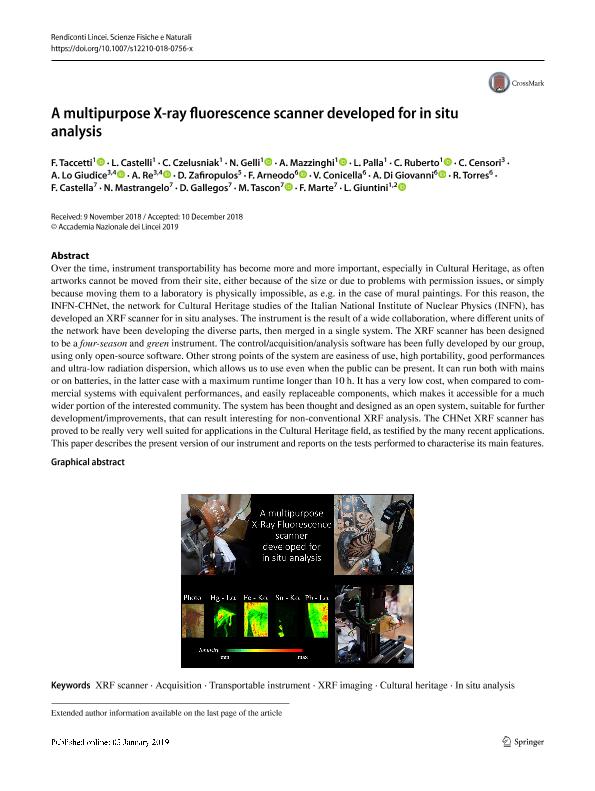Artículo
A multipurpose X-ray fluorescence scanner developed for in situ analysis
Taccetti, F.; Castelli, L.; Czelusniak, C.; Gelli, N.; Mazzinghi, A.; Palla, L.; Ruberto, C.; Censori, C.; Lo Giudice, A.; Re, A.; Zafiropulos, D.; Arneodo, F.; Conicella, V.; Di Giovanni, A.; Torres, R.; Castella, F.; Mastrangelo, Noemi Elisa ; Gallegos, D.; Tascon, Marcos
; Gallegos, D.; Tascon, Marcos ; Marte, F.; Giuntini, L.
; Marte, F.; Giuntini, L.
 ; Gallegos, D.; Tascon, Marcos
; Gallegos, D.; Tascon, Marcos ; Marte, F.; Giuntini, L.
; Marte, F.; Giuntini, L.
Fecha de publicación:
06/2019
Editorial:
Springer Verlag Berlín
Revista:
Rendiconti Lincei
ISSN:
2037-4631
e-ISSN:
1720-0776
Idioma:
Inglés
Tipo de recurso:
Artículo publicado
Clasificación temática:
Resumen
Abstract: Over the time, instrument transportability has become more and more important, especially in Cultural Heritage, as often artworks cannot be moved from their site, either because of the size or due to problems with permission issues, or simply because moving them to a laboratory is physically impossible, as e.g. in the case of mural paintings. For this reason, the INFN-CHNet, the network for Cultural Heritage studies of the Italian National Institute of Nuclear Physics (INFN), has developed an XRF scanner for in situ analyses. The instrument is the result of a wide collaboration, where different units of the network have been developing the diverse parts, then merged in a single system. The XRF scanner has been designed to be a four-season and green instrument. The control/acquisition/analysis software has been fully developed by our group, using only open-source software. Other strong points of the system are easiness of use, high portability, good performances and ultra-low radiation dispersion, which allows us to use even when the public can be present. It can run both with mains or on batteries, in the latter case with a maximum runtime longer than 10 h. It has a very low cost, when compared to commercial systems with equivalent performances, and easily replaceable components, which makes it accessible for a much wider portion of the interested community. The system has been thought and designed as an open system, suitable for further development/improvements, that can result interesting for non-conventional XRF analysis. The CHNet XRF scanner has proved to be really very well suited for applications in the Cultural Heritage field, as testified by the many recent applications. This paper describes the present version of our instrument and reports on the tests performed to characterise its main features.
Archivos asociados
Licencia
Identificadores
Colecciones
Articulos (IIIA)
Articulos de INSTITUTO DE INVESTIGACION E INGENIERIA AMBIENTAL
Articulos de INSTITUTO DE INVESTIGACION E INGENIERIA AMBIENTAL
Citación
Taccetti, F.; Castelli, L.; Czelusniak, C.; Gelli, N.; Mazzinghi, A.; et al.; A multipurpose X-ray fluorescence scanner developed for in situ analysis; Springer Verlag Berlín; Rendiconti Lincei; 30; 2; 6-2019; 307-322
Compartir
Altmétricas



